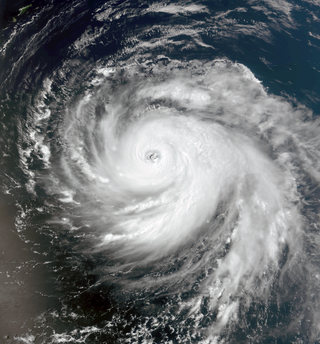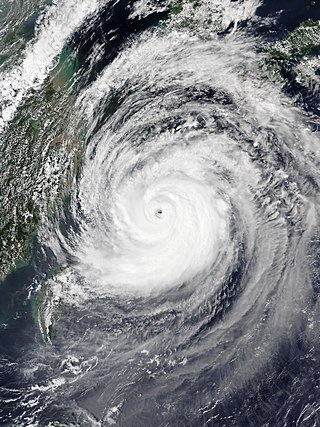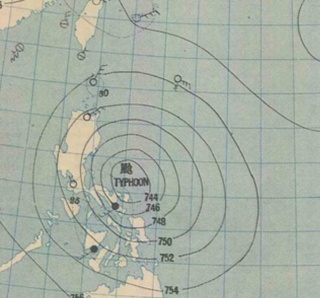
The 1964 Pacific typhoon season was the most active tropical cyclone season recorded globally, with a total of 39 tropical storms forming. It had no official bounds; it ran year-round in 1964, but most tropical cyclones tend to form in the northwestern Pacific Ocean between June and December. These dates conventionally delimit the period of each year when most tropical cyclones form in the northwestern Pacific Ocean.

Typhoon Ike, known in the Philippines as Typhoon Nitang, was the second deadliest tropical cyclone in the 20th century in the Philippines. Ike originated from an area of disturbed weather southeast of Guam on August 21, 1984, and five days later, developed into a tropical depression. Following an increase in organization, the depression attained tropical storm intensity on August 27. Initially tracking west-southwest, the storm gradually gained strength as wind shear resulted relaxed and Ike became a typhoon on August 30. Continuing to rapidly intensity, Ike turned west and attained peak intensity on September 1, with the Japan Meteorological Agency estimating winds of 170 km/h (105 mph). At around 14:00 UTC that day, Ike made landfall on the northeastern tip of Mindanao. The cyclone emerged into the South China Sea on September 3 as a tropical storm before re-intensifying into a typhoon and moving onshore Hainan. Ike then struck the Chinese mainland as a tropical storm in Guangxi and dissipated on September 6.

The 1951 Pacific typhoon season was a generally average season with multiple tropical cyclones striking the Philippines. With the exception of January, each month saw at least one tropical system develop; October was the most active month with four tropical cyclones forming. Overall, there were 31 tropical depressions, of which 25 became tropical storms; of those, there were 16 typhoons.

Typhoon Nabi, known in the Philippines as Typhoon Jolina, was a powerful typhoon that struck southwestern Japan in September 2005. The 14th named storm of the 2005 Pacific typhoon season, Nabi formed on August 29 to the east of the Northern Mariana Islands. It moved westward and passed about 55 km (34 mi) north of Saipan on August 31 as an intensifying typhoon. On the next day, the Joint Typhoon Warning Center upgraded the storm to super typhoon status, with winds equivalent to that of a Category 5 hurricane on the Saffir–Simpson Hurricane Scale. The Japan Meteorological Agency estimated peak ten-minute winds of 175 km/h (109 mph) on September 2. Nabi weakened while curving to the north, striking the Japanese island of Kyushu on September 6. After brushing South Korea, the storm turned to the northeast, passing over Hokkaido before becoming extratropical on September 8, before dissipating on September 12.

The 2019 Pacific typhoon season was the costliest Pacific typhoon season on record, just ahead of the previous year. The season featured fairly above-average tropical cyclone activity for the second consecutive year, producing 29 named storms, 17 typhoons, and five super typhoons. The season's first named storm, Pabuk, reached tropical storm status on January 1, becoming the earliest-forming tropical storm of the western Pacific Ocean on record, breaking the previous record that was held by Typhoon Alice in 1979. The season's first typhoon, Wutip, reached typhoon status on February 20. Wutip further intensified into a super typhoon on February 23, becoming the strongest February typhoon on record, and the strongest tropical cyclone recorded in February in the Northern Hemisphere. The season's last named storm, Phanfone, dissipated on December 29 after it made landfall in the Philippines.

In September 1934, a violent typhoon caused tremendous devastation in Japan, leaving more than 3,000 people dead in its wake. Dubbed the Muroto typhoon, the system was first identified on September 13 over the western Federated States of Micronesia. Moving generally northwest, it eventually brushed the Ryukyu Islands on September 20. Turning northeast, the typhoon accelerated and struck Shikoku and southern Honshu the following morning. It made landfalls in Muroto, Kaifu, Awaji Island, and Kobe. A pressure of 911.9 hPa (26.93 inHg) was observed in Muroto, making the typhoon the strongest ever recorded to impact Japan at the time. This value was also the lowest land-based pressure reading in the world on record at the time; however, it was surpassed the following year during the 1935 Labor Day hurricane. After clearing Japan, the now extratropical storm traveled east and weakened. Turning north by September 24, the system deepened and impacted the Aleutian Islands; it was last noted the following day over western Alaska.

Typhoon Ida, also known as the Kanogawa Typhoon, was the sixth-deadliest typhoon to hit Japan, as well as one of the strongest tropical cyclones on record. On September 20, Ida formed in the Western Pacific near Guam. It moved to the west and rapidly intensified into a 185 km/h (115 mph) typhoon by the next day. On September 22, Ida turned to the north and continued its quick rate of intensification. Two days later, the Hurricane Hunters observed a minimum barometric pressure of 877 mb (25.9 inHg), as well as estimated peak winds of 325 km/h (202 mph). This made Ida the strongest tropical cyclone on record at the time, although it was surpassed by Typhoon June 17 years later. Ida weakened as it continued to the north-northeast, and made landfall in Japan on southeastern Honshū with winds of 130 km/h (80 mph) on September 26. It became extratropical the next day, and dissipated on the September 28 to the east of the country. Ida caused torrential flooding to southeastern Japan, resulting in over 1,900 mudslides. Damage was estimated at $50 million, and there were 1,269 fatalities.

Typhoon Soulik, known in the Philippines as Typhoon Huaning, was a powerful tropical cyclone that caused widespread damage in Taiwan and East China in July 2013. The storm originated from an upper-level cold-core low well to the northeast of Guam on July 6. Gaining tropical characteristics, the system soon developed a surface low and became a tropical depression early on July 7. Tracking generally westward, a motion it would retain for its entire existence, the depression underwent a period of rapid intensification starting on July 8 that culminated in Soulik attaining its peak strength early on July 10. At that time, the system had sustained winds estimated at 185 km/h (115 mph) and barometric pressure of 925 mbar. Thereafter, an eyewall replacement cycle and cooler waters weakened the system. Though it passed over the warm waters of the Kuroshio Current the following day, dry air soon impinged upon the typhoon. Soulik later made landfall late on July 12 in northern Taiwan before degrading to a tropical storm. Briefly emerging over the Taiwan Strait, the storm moved onshore for a second time in Fujian on July 13. The system was last noted as a tropical depression early on July 14.

Typhoon Wendy was a weak typhoon that damaged Japan in August of the 1960 Pacific typhoon season. On August 10, a tropical depression formed near Typhoon Virginia and strengthened to a tropical storm later that day, receiving the name Wendy from the Joint Typhoon Warning Center (JTWC). The storm continued to intensify as it traveled toward the Japanese archipelago, becoming a typhoon a day after formation. The typhoon peaked with winds of 140 kilometres per hour (85 mph) while located south of Japan. Wendy made landfalls in Shikoku and Honshu on August 12, and became extratropical on August 13. The Japan Meteorological Agency (JMA) stopped tracking the cyclone on August 15.

Typhoon Charlotte was a damaging typhoon that struck Okinawa during the 1959 Pacific typhoon season. An area of low pressure developed in early October, and it became a tropical depression on October 9. The depression strengthened to a tropical storm one day later, and it received the name Charlotte from the Joint Typhoon Warning Center (JTWC). The system strengthened quickly and became a typhoon eighteen hours later. Charlotte continued to rapidly strengthen to its peak of 260 km/h (160 mph) on October 13. The typhoon began to weaken afterwards, and it traveled south of Okinawa on October 16. The typhoon weakened to a tropical storm on October 19 as it began its extratropical transition. The storm became extratropical later that day, and the Japan Meteorological Agency (JMA) ceased tracking the system on October 20.

Typhoon Emma was a strong typhoon that struck Okinawa during the 1959 Pacific typhoon season. An area of severe weather formed near Kwajalein Atoll on October 30, and the Japan Meteorological Agency (JMA) began tracking it as a tropical depression on November 1. The Joint Typhoon Warning Center followed suit on November 5 after finding a closed circulation, and the depression received the name Emma. The depression strengthened into a tropical storm west of Guam on November 6 and gradually gained strength. Emma became a typhoon on November 11 near Luzon, and it reached its peak sustained winds of 205 km/h; 125 mph (110 kn) later that day. The typhoon turned northeastwards and grazed Okinawa the next day. Emma steadily weakened and became extratropical on November 13, and the JMA ceased tracking the storm on November 15.

Typhoon Alice was a typhoon that brought severe flooding to Guam during the latter part of the 1953 Pacific typhoon season. The system was first tracked near the Marshall Islands on October 11 by the Fleet Weather Central (FWC) as a tropical storm, and the Central Meteorological Observatory (CMO) as a tropical depression. The CMO upgraded Alice to a tropical storm east of Guam on October 14. One day later, and the FWC reported that the storm had intensified to 65 knots, equivalent to a Category 1 typhoon on the Saffir–Simpson scale. Near Iwo Jima, the typhoon traveled northeastwards, reaching its peak of 100 kn late on October 18. Alice then steadily weakened down to a tropical storm on October 20. The storm became extratropical on October 23 near the International Date Line, and both agencies ceased tracking the cyclone.

Typhoon Jebi, known in the Philippines as Super Typhoon Maymay, was the costliest typhoon in Japan's history in terms of insured losses. Jebi formed from a tropical disturbance south-southwest of Wake Island on August 26 and became the twenty-first named storm of the 2018 Pacific typhoon season on August 27. Amid favorable environmental conditions, Jebi quickly strengthened into a typhoon on August 29 as it headed west and rapidly intensified as it passed the Northern Mariana Islands on August 30. Jebi reached its peak intensity as a Category 5-equivalent typhoon on August 31, with 10-minute sustained winds of 195 km/h (120 mph), 1-minute sustained winds of 285 km/h (180 mph), and a minimum pressure of 915 hPa. Afterwards, Jebi began a slow weakening trend as it turned northwest, briefly passing through the Philippine Area of Responsibility on September 2. Jebi accelerated north-northeast towards Japan on September 3 as it interacted with the westerlies, and made landfalls over Shikoku and near Kobe early on September 4. Jebi quickly weakened over land and became an extratropical cyclone later that day over the Sea of Japan. Its remnants moved over the Russian Far East before dissipating on September 9.

Typhoon Maysak, known in the Philippines as Typhoon Julian, was a deadly, damaging and powerful tropical cyclone that struck the Ryukyu Islands and the Korean Peninsula in September 2020. The third typhoon of the 2020 Pacific typhoon season, Maysak formed from a tropical disturbance. The disturbance gradually organized, receiving the name Julian from PAGASA as it became a tropical depression. As the depression strengthened, the JMA subsequently named the system Maysak. Maysak rapidly intensified into a strong typhoon before weakening and making landfall in South Korea.

Typhoon Jane was a catastrophic and deadly tropical cyclone that left significant effects to Japan during the 1950 Pacific typhoon season. It caused over 398 reported deaths and 141 to be missing, mainly due to the landslides and flooding. It also destroyed some battle and cargo ships. The sixth reported typhoon of the season, Jane was first mentioned in weather maps as a tropical depression to the east of the Philippines. It quickly strengthened to a tropical storm as it moved to the northwest. It then curved to the northeast, reaching its peak intensity of 185 km/h before weakening and striking Minami in Tokushima Prefecture on September 3 as a Category 2 typhoon. It quickly weakened, passing through the Awaji Island and Kobe before becoming extratropical in the Sea of Japan on the same day. The extratropical remnants of the system persisted until it was no longer tracked on September 7.

Typhoon Dinah was a tropical cyclone that brought heavy damages to Japan, while leaving 65 fatalities and 70 to be missing, all in that country alone. It is also one of the disasters that happened in the country during the Showa 27 era. The second typhoon of the 1952 Pacific typhoon season, Dinah was first mentioned in weather maps as a tropical depression to the east of Visayas. It gradually organized, becoming a tropical storm on June 21 as it skirted the northeastern Philippines, with the Fleet Weather Center naming it Dinah. It strengthened further to a minimal typhoon as it moved through the Nansei Islands on June 22, before reaching its peak intensity of 140 km/h, as estimated by the Fleet Center. It then weakened shortly, before passing near Shikoku on the next day, then making landfall through the southern part of the Kii Peninsula before gradually weakened further and started to undergo extratropical transition as it moved out of the country on June 24. It then became fully extratropical on the next day.

Typhoon Ione was a catastrophic and deadly tropical cyclone that left over 512 confirmed deaths and another 326 to be missing as it affected Japan, with the majority of the fatalities coming from the city of Ichinoseki in Iwate Prefecture. It also left a significant trail of damage on the country, just after Typhoon Kathleen devastated the area. The fourteenth named storm and the ninth typhoon of the 1948 Pacific typhoon season, Ione was first seen in weather maps as a tropical storm near the Mariana Islands on September 11. It moved to the northwest, passing through the island country, before strengthening to a typhoon on September 13. It rapidly organized to a Category 4 typhoon and reached its peak intensity on the next day before slowly weakening as it started to approach the Japanese archipelago, while curving to the northeast. It then made landfall on September 16 between the present cities of Tateyama and Kisarazu in Chiba Prefecture as a minimal typhoon. It then passed through the southern coast of Hokkaido, before gradually degraded to a tropical storm as it emerged in the Pacific Ocean on the next day. It then became extratropical, shortly after.

The September 1929 Philippines typhoon was a destructive tropical cyclone that killed over 200 individuals in the Philippine Islands during the 1929 Pacific typhoon season. It was first noted on August 31 to the east of Manila while moving to the west. It then became a typhoon while turning to the west-northwest, hitting the Bicol Region while recording a minimum barometric pressure of 954.62 hPa early the next day on Polillo, Quezon. After crossing the archipelago, it turned to the northwest before dissipating through the weather maps on September 6.

Severe Tropical Storm Kompasu, known in the Philippines as Severe Tropical Storm Maring was a very large and deadly tropical cyclone that affected the Philippines, Taiwan, and southeast China. Part of the 2021 Pacific typhoon season, Kompasu originated from an area of low pressure east of the Philippines on 6 October 2021. The Japan Meteorological Agency (JMA) classified it as a tropical depression that day. A day later, the Philippine Atmospheric, Geophysical and Astronomical Services Administration (PAGASA) classified it as a tropical depression, naming it Maring. The cyclone was initially heavily disorganised, competing with another vortex, Tropical Depression Nando. Eventually, Maring became dominant, and the JMA reclassified it as a tropical storm, naming it Kompasu. Kompasu made landfall in Cagayan, Philippines, on 11 October 2021, and two days later, the storm made landfall in Hainan, China. The cyclone dissipated on 14 October 2021 while located over Vietnam.

Typhoon Wilda was an intense typhoon that was tied for lowest central pressure of any typhoon in 1964, along with Typhoon Sally. As the twenty-fourth named storm of the season, it origins can be traced back to when it was as a tropical storm east-southeast of Guam on September 16. Wilda moved northwestward for multiple days. it was identified as a tropical storm by Joint Typhoon Warning Center on September 19, strengthening into a typhoon that day. It reached its peak intensity over the Philippine Sea. Wilda slightly weakened following peak strength before curving northward and making landfall on September 24. The storm would eventually emerge into the Sea of Japan and curve northeast. Wilda made a final landfall on September 25 as a tropical storm, thereafter, departing Japan and quickly moving towards the central Aleutian Islands as a powerful extratropical cyclone, dissipating on September 27.






















